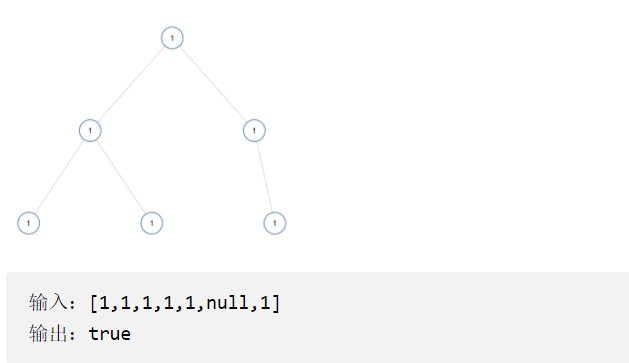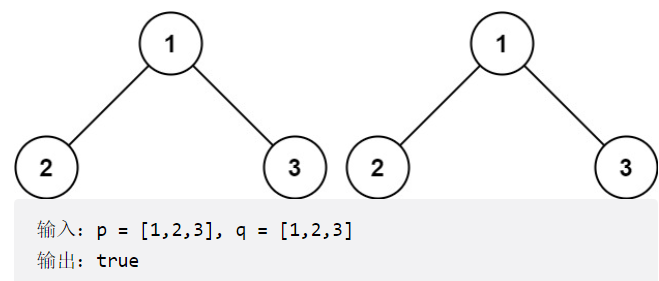Catalog
Summary of Today's Brush Topics
Single-valued binary tree (easy)
Prime number calculation position (easy) in binary representation
Number (mid)II that occurs only once
Summary of Today's Brush Topics
Single-valued binary tree (easy)
Title link: 965.Single Value Binary Tree-Force Button (leetcode-cn.com)
Title Description
If each node of a binary tree has the same value, the binary tree is a single-valued binary tree.
Returns true only if the given tree is a single-valued binary tree. Otherwise, it returns false.
Example


Solving problems
Recursive traversal: Completes a recursive traversal using a Boolean type auxiliary function. In the main function, the root node value root.val and the root node root are passed into the auxiliary function to allow the auxiliary function to complete the recursive comparison.
Variable: Auxiliary function parameter An integer val ue A node TreeNode.
Code
class Solution {
public boolean isUnivalTree(TreeNode root) {
if(root.left == null && root.right == null){
return true;
}
int val = root.val;
return singleNumber(val,root);
}
public boolean singleNumberTree( int val, TreeNode root){
if(root == null){
return true;
}
if(root.val != val){
return false;
}
return singleNumber(val,root.left) && singleNumber(val,root.right);
}
}The same tree (easy)
Title link: 100.Same tree-snap (LeetCode) (leetcode-cn.com)
Title Description
Give you the root nodes p and q of two binary trees and write a function to check if they are the same.
If two trees are structurally identical and nodes have the same value, they are considered identical.
Example

Solving problems
Recursive comparison: The idea is very simple. Traverse through each node of two trees to compare values. One node is empty, the other is empty.
Omnipotent recursion, Ha Ha Ha Ha Ha Ha has come to water again.
Code
class Solution {
public boolean isSameTree(TreeNode p, TreeNode q) {
if(p == null){
return q == null;
}
if(q == null){
return p == null;
}
if(p.val != q.val ){
return false;
}
return isSameTree(p.left,q.left) && isSameTree(p.right,q.right);
}
}Prime number calculation position (easy) in binary representation
Title link: Prime number calculation position in binary representation
Title Description
Given two integers L and R, find the range of closed intervals [L, R], and calculate the number of integers with Prime digits.
(Note that computed bits represent the number of 1 in a binary representation. For example, binary representation 10101 of 21 has three computed bits. Also, 1 is not a prime number.)
Example
Input: L = 10, R = 15
Output: 5
Explanation:
10 -> 1010 (2 computed bits, 2 is prime)
11 -> 1011 (3 computed bits, 3 is prime)
12 -> 1100 (2 computed bits, 2 is prime)
13 -> 1101 (3 computed bits, 3 is prime)
14 -> 1110 (3 computed bits, 3 is prime)
15 -> 1111 (4 computed bits, 4 not prime)
Be careful
-
L, R is an integer L <= R in [1, 10^6].
-
The maximum value of R - L is 10000.
Solving problems
Enumeration+Bit Operation:
-
Enumeration: Since the range of L and R in this topic is within 10 ^ 6, the binary integer representation of R does not exceed 20 bits (20 times of 2 is 1048576), so the maximum prime number in the number of digits is 19 and the amount of data is small, you can consider enumerating prime numbers in 2 - 20.
-
Bit operation: Yesterday's article on the use of bits has a quick solution to the number of binary bits in a number, namely lowbit.
I don't know a buddy. I can go and see that. The link is here.
Code
class Solution {
public int countPrimeSetBits( int left, int right) {
int count = 0;
while( left <= right ) {
int sum = 0;
int m = left;
while(m != 0){
int c = m & ( -m);
m -= c;
sum ++;
}
left ++;
count = check(sum) ? count + 1 : count;
}
return count;
}
public boolean check(int num){
return num == 2 || num == 3 || num == 5 || num == 7 || num == 11 ||num == 13||num == 17||num == 19;
}
}Number (mid)II that occurs only once
Title link: Number II - Submit Record - LeetCode (leetcode-cn.com) that occurs only once
Title Description
Give you an array of integers, nums, where each element occurs exactly three times, except for one that occurs only once. Please find out and return the element that only appears once.
Example
Input: nums = [2,2,3,2] Output: 3 Input: nums = [0,1,0,1,0,1,99] Output: 99
Solving problems
Hashtable: Traverse through the array, creating a hash table to record the number of occurrences of each number, returning an occurrence of 1 element.
Bit operation: We know that if two numbers are not equal, then they must have some binary digits that are not the same, so we can record the number of occurrences of 1 in the k-bit binary number of all the numbers in the array. If the number occurs three times in the array, then count must be divisible by 3, otherwise, the number that occurs once must be 1 in the k-bit. We just need to record every one of these k-bits and get every Add 1 << K.
Bit Operations Article: Smart bitwise operations_
Code
class Solution {
public int singleNumber(int[] nums) {
if(nums.length == 1){
return nums[0];
}
int res = 0;
for(int i =0;i < 32 ;i ++){
int count = 0;
for(int item : nums){
if(( item & 1 << i) == 1<<i){
count ++;
}
}
if(count %3 == 1){
res |= (1 << i);
}
}
return res;
}
}supplement
Today, I watched Queen N and its optimization problems, which is really a beginner's nightmare, but after reading, I also understood some recursive characteristics, Cheese Cheese!!!
Okay, let's get here today (another day on water) and continue to feed the ducks tomorrow.